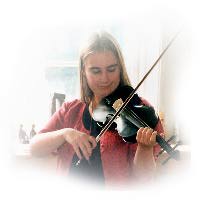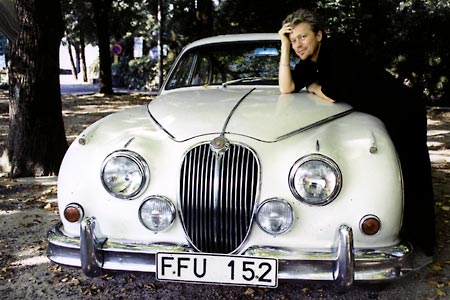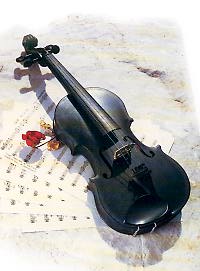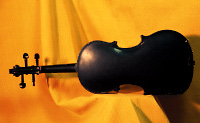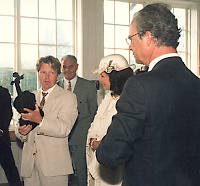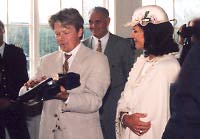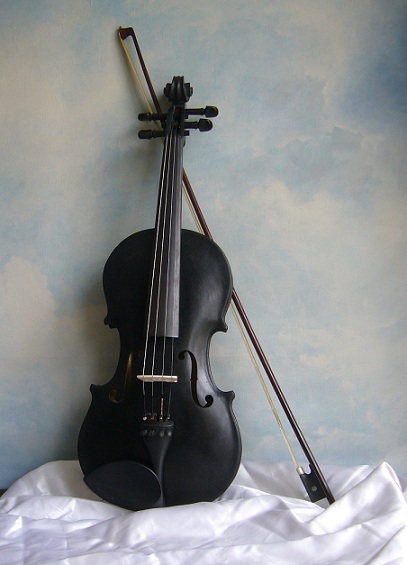
Blackbird
|
Marie Axelsson handling the Blackbird.
Lars Widenfalk, creator of the Blackbird |
BlackbirdThe Black Stone Violin
The black stone violin Blackbird, the only one of its kind in the world, was made by Swedish artist and sculptor Lars Widenfalk. Constructed to the designs of Stradivarius, it uses Lars´ own technical solutions. Lars spent two years working on his violin, while continuing his creative work at the same time. Curiosity apart, what drove him on was the desire to discover just how far stone, in this case diabase, could be pressed as an artistic material. |
|
Photo: Jan Olby |
The belly of the violin is only 2.5 mm thick at its thinnest point. Such was the precision with which the belly was constructed, with its sound-holes, back and graceful scroll. The ribs were made in one piece by first sawing out a 30 mm thick plate shaped to form the external contour, and then, with infinite care, removing the inside using water-drill and hand-tools so as to create a thin rib, no more than a couple of millimetres thick at its thinnest point. Stone may seem stable, static material, lacking in "give"; but when the work on the ribs was almost complete, they fractured at a point where the stone had a "give" of approximately 15 mm. Diabase is a very dense crystalline rock deriving from the interior of the Earth in the form of magma which solidified 1.6 billion years ago.
|
|
|
The idea of constructing a musical instrument from this material came to Lars when he was working on two big diabase stones destined to form part of the artistic embellishment of the Norwegian TV building in Oslo. As he moved over the rock, creating his sculptures with hammer and chisel, it gave off a strikingly beautiful sound like a bronze bell. Earlier the same year Lars had acquired the headstone from his grandfather´s grave, which was to be disposed of following the construction of a bigger family grave. Of exquisite quality and blackness the stone probably came from the deep quarries of Northern Skåne. The use to which Lars would put this splendid material now became clear to him: the size was right, and he would turn it into the first - and only - playable stone violin the world had ever seen or heard. A fascinating thought: what did primary rock - Mother Earth - sound like? Would it be possible to capture in a single instrument the sound of which we all form part?
|
|
Lars Widenfalk shows the Blackbird to Queen Silvia and King Carl XVI Gustaf.
Queen Silvia is impressed by the diabase surface. |
Inspired, methodical, the sculptor worked on his violin, section by section. When it was time to make the back plate, the material from the headstone had been used up, and Lars had to go out himself and cut a block of Härjedalen rock, a beautiful porphyry resembling diabase, black with pale flecks. It is of this stone that the back of the violin is made. Widenfalk was now ready with the three parts that comprise the corpus of the violin, its interior surface finished with real gold so as to produce the finest possible tone. Precision bonding of the parts was done using two components of glue and the neck secured with two silver steel pins pins where it was joined to the body. This was the base material and the basic structure. But before the music of the Earth could be heard, it was necessary to have recourse also to material from the other two "kingdoms": animal and vegetable. The finger board, pegs, tailpiece, and chin-rest were of course all made of the traditional black ebony. In order to ensure that the pegs would fit perfectly and not slip, Lars had to construct conical drills, since the pegs themselves are conical and are tightened to produce the righ pitch. |
|
|
Slowly, as he watched his violin take shape, Lars' thoughts turned to Stradivarius and his violins, and it came back to him that Stradivarius' creations often had their own individual names connected with birds. Once the stone violin was polished gleaming black, the name was obvious: it had to be Blackbird! A bit pretentious, perhaps: the blackbird is the most beautiful of songsters. But still. And since the blackbird's bill is yellow, the perfect solution was of course a bridge of the yellowest ivory that could be found: mammoth! This also saved the artist from clashing with nature conservancy interests, concerned about the threat to the elephant. After many trials and tribulations, contact was established with a Russian artist, who in his turn had the right contacts in the interior Siberia, way out on the taiga and deep in the permafrost. A suitable piece was obtained and dispatched to Lars' studio in Medelpad, Sweden. It was an exciting moment when the bridge - cut with a fret-saw - was fitted and the strings tightened. The first notes sounded, Lars felt a frisson run through him and the black stone violin trembled into life. |
|
Blackbird in China. Click to view! |
The violin was created and built by human hand and it is the human hand - the hand of the violinist - that gives it its soul and confers on Mother Earth a sound and a voice. The "Blackbird", the only violin of its kind in the world, was ready in time for Swedish composer Sven David Sandström to compose music specially for the instrument, which received its first performance in the Swedish Pavilion at World Expo 92 in Seville. Since then, the violin has been exhibited and played in Washington, Nüremberg and Monza; hopefully its world tour will be extended and it will be able to go on emitting its unique sound, its melancholy song, bringing pleasure and stirring the imagination.
|
|
Would you like to see and perhaps hear this unique instrument? Concerts and exhibitions can be arranged.
|
|

